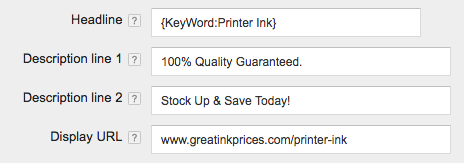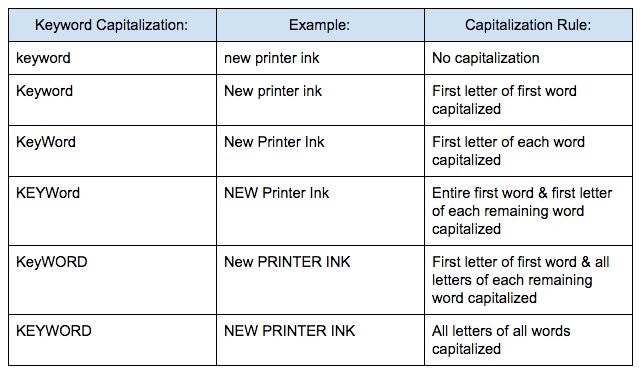
If you have ever run a Google AdWords campaign, you know how overwhelming maintaining an account can be. Luckily, Google has many features and tools that make managing campaigns easier and more successful. The catch? It is up to us to utilize them. Today, I am talking about an advanced feature that can help advertisers better reach customers by matching their search query. This seemingly magical feature is called keyword insertion.
What is Keyword Insertion?
Simply put, keyword insertion allows you to customize ad text based on the search term a customer uses. This helps provide a more relevant ad to the person searching and, in theory, higher click through rates.
For example, if you sell office supplies and you have an ad group for printer ink with keywords such as HP 564 ink, HP 920 ink, HP 951 ink etc. Using keyword insertion would automatically update your ad text to the term that is searched for. Check out the ads below, the search term “Buy HP 564 ink” and “Buy HP 920 ink” are met by the same ad but with modified text that includes the specific keywords.


Why Would I Use Keyword Insertion?
By having a more customized ad that includes the keyword of a customer’s search query, advertisers are able to speak directly to what the customer wants. For example, if you search for “inbound marketing packages”, an advertiser can set up their ad to say exactly what you typed in. Not only does this draw your eye to the ad with your exact search phrase, but it also gives you a better user experience as you’ve found exactly what you’re looking for.
As you can imagine, keyword insertion is highly beneficial to businesses with large inventories that have variations of the same item. These businesses can then make one ad with dynamic keyword insertion that adapts to each of their ad group’s keywords instead of wasting time and energy on building new corresponding ads.
How Do I Use Keyword Insertion?
Now that we know how convenient using keyword insertion can be, how exactly does it work? This is where our text ad comes in. When creating a keyword insertion ad, you will insert a code into the headline (or the body of text if that’s where you want the ad to change). Here is what it would look like:

Google will then attempt to replace this code with one of the ad group’s keywords. If a searcher’s query is not a match for one of your keywords, the text following the code will be used as a generic replacement. In this above example, “Printer Ink” would be used.
Note that the code in the example above contains brackets, the word "KeyWord" (with my desired capitalization which we will cover below), and the default ad text after the colon that the ad will use as a generic replacement if need be.Ex. {KeyWord:Printer Ink}
A Word of Warning
Now that we've gone over how beneficial keyword insertion can be and how to use it, it’s time to bring up a word of warning so you know what to avoid. There are several things that could go wrong when using keyword insertion including:
- One word headlines - If you have a headline with just an inserted singular keyword your ad will not only look boring but also spammy.
- Oddly worded text - Depending on the keywords in your ad group your ad could end up oddly worded. Ad text that makes sense for some keywords may not for others.

- Use of competitor's name - While it is perfectly legal to bid on keywords that include your competitor’s name, you might run into copyright issues if you use it in the header of your ad.
- Wrong code entered - If the keyword insertion code is entered with extra spaces, parenthesis instead of brackets, or incorrect use of capitalization (see image below). It will effect your ad.

Lastly, keep in mind that keyword insertion is best when used with highly targeted ad groups. Industries such as ecommerce stores are a great example, as they have many products in a specific category.
Learn More
Hopefully this article has enlightened you on how keyword insertion can be of benefit in running an AdWords campaign. Just remember this feature isn't for everyone and, like any other tool, it has its pros and cons! For more information on Google AdWords and integrating it with your inbound marketing strategy, Check out this FREE eBook "Why Google AdWords Should Be Part of Your Inbound Marketing Strategy":

from HubSpot Marketing Blog http://blog.hubspot.com/marketing/google-adwords-keyword-insertion
Via http://blog.hubspot.com/marketing/google-adwords-keyword-insertion
No comments:
Post a Comment